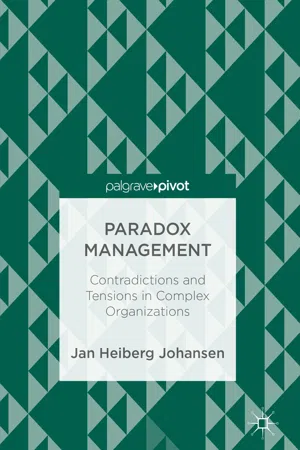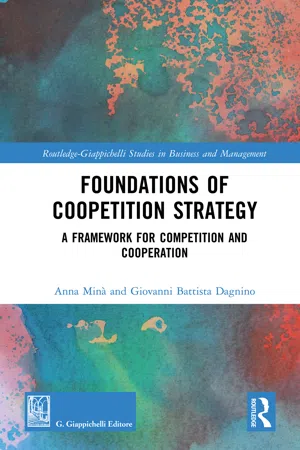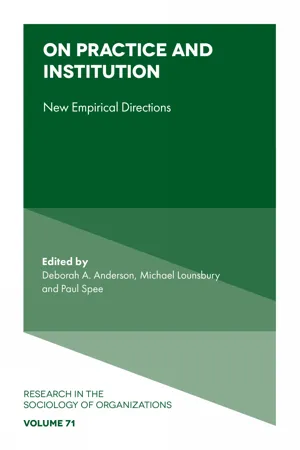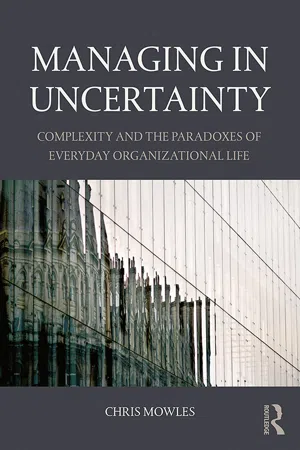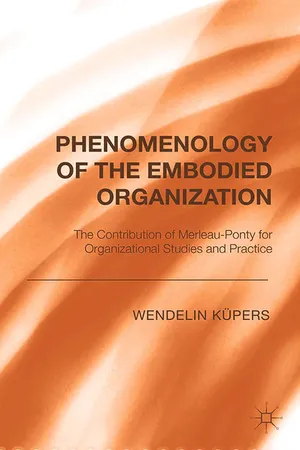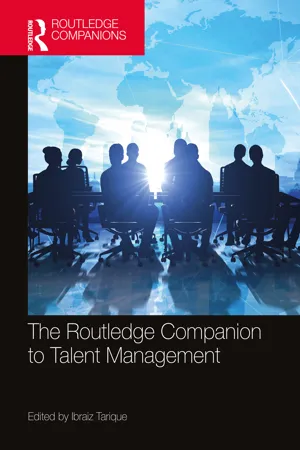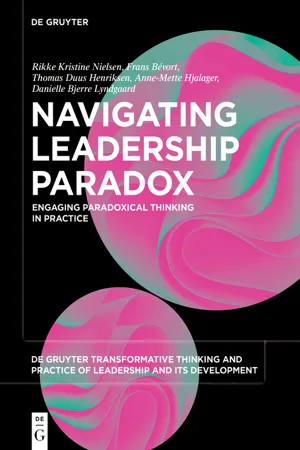Business
Paradox Theory
The Paradox Theory in business refers to the idea that contradictory elements can coexist and even complement each other. It suggests that successful businesses are able to navigate and leverage opposing forces, such as stability and change, efficiency and innovation, or short-term and long-term goals. Embracing these paradoxes can lead to greater adaptability and competitive advantage in the business world.
Written by Perlego with AI-assistance
Related key terms
11 Key excerpts on "Paradox Theory"
- eBook - ePub
Global Software Engineering
Virtualization and Coordination
- Gamel O. Wiredu(Author)
- 2019(Publication Date)
- Auerbach Publications(Publisher)
7Paradox of OrganizationIn organization theory, paradox refers to contradictory or conflicting yet interrelated factors that exist simultaneously. Paradox has been an influential framework for organizational research since its analytical power was espoused by Kim S. Cameron and Robert E. Quinn,1 Marshall S. Poole and Andrew H. Van de Ven,2 and Jennifer L. Sparr.3 It is useful for analyzing complex, plural, divergent, and disruptive situations in organizations. Its philosophical and rhetorical origins are traceable to the Megaric philosophers of 400 bc who studied the well-known liar antinomy. Their famous example of paradox is this logical one: if a man says, “I always lie,” how should we understand what he says? There are also rhetorical paradoxes which are statements that appear to be contradictory or absurd but are true. An example is in George Orwell’s Animal Farm : “all animals are equal, but some are more equal than others.” The theoretical tension in logical paradoxes and literary tensions in rhetorical paradoxes have led the way to the study of organizational paradox. In Poole and Van de Ven’s admonition to scholars to embrace organizational paradoxes and use them to build theories, they wrote:An alternative strategy for theory building can be proposed: Look for theoretical tensions or oppositions and use them to stimulate the development of more encompassing theories. This strategy requires an exploration of the tradition of theoretical debate surrounding important issues, an identification of alternative or opposing theories or explanations, and discovery of ways of relating, contraposing, or integrating them. The result will be theories less susceptible to the limitations of perspective which attend many middle range theories.4On the whole, paradox has proven to be both an ontological and epistemological device for handling organizational tensions to generate theories. It confronts rather than ignores those tensions that reflect incompatible or inconsistent theories. The theories may appear inconsistent or incompatible, but that may be due to the underlying assumption, perspective, and explanatory principle. If theory development is a discourse, then to use paradox to develop global software engineering (GSE) coordination theory is to use it as a rhetorical device. For this reason, Poole and Van de Ven propose acceptance of paradoxes, spatial and temporal separation of paradoxes, and the introduction of new terms (literary devices) to resolve the paradoxes. - eBook - ePub
Paradox Management
Contradictions and Tensions in Complex Organizations
- Jan Heiberg Johansen(Author)
- 2018(Publication Date)
- Palgrave Pivot(Publisher)
2003 ). Thus, organizational actors should strive to make sense of paradoxical tensions rather than hide them away.Chapter Summary: Paradoxes Unite Theory Positions
Paradox Theory embraces such diverse positions as functional theory, critical theory, structuration , Taoist theory, and psychotherapeutic theory. It can nuance the understanding of organizations to bring different perspectives in use within the same overall optic. In this way, paradox management can contribute to more well-rounded images of the challenging organizational reality.In the introduction, skeptical and optimistic views of paradox management were touched upon. The skeptical view reduces the paradox concept to yet another buzzword in management. Paradox management shows the way to hell by defining impossible demands as a condition for organizations. Paradox thinking can be criticized as a paradoxism , that is, an excessive use of juxtapositions without relation to the perceived reality. The optimistic view considers paradox management as an inclusive meta-theory that can help create competitive organizations by integrating and transcending organizational paradoxes.The story of how paradox management has evolved within organizational theory presents a more nuanced reality. Both skeptical and optimistic approaches to Paradox Theory overlook important points. The skeptical view overlooks the evidence that organizational actors experience paradoxical tensions and the fact that Paradox Theory is used in a wide range of theoretical perspectives on management. The literature includes evidence of organizational paradoxes through thorough empirical studies, and it includes critical optics of organizations focusing on how to unmask misuse of power. The optimistic view ignores that it is important to specify the scope of the paradox concept to establish a foundation for - eBook - ePub
Foundations of Coopetition Strategy
A Framework for Competition and Cooperation
- Anna Minà, Giovanni Battista Dagnino(Authors)
- 2021(Publication Date)
- Routledge(Publisher)
et al., 2019, p. 108).Overall, “since paradoxes are persistent, the tensions are never fully resolved, but only managed through mechanisms that recognize their persistence” (Keller & Sadler-Smith, 2019, p. 165). Consequently, firms should acknowledge what are the opposites they have to deal with (e.g., rational planning vs. emergent planning, commitment vs. flexibility, mass market vs. niche market), rather simply than choosing between them (Handy, 1994; Pinto, 2019), and understand that to respond to such opposite demands implies ongoing responses (Keller & Sadler-Smith, 2019; Pinto, 2019; Smith & Tracey, 2016).As we can see, for this reason “the paradox literature has become increasingly crowded” (Smith & Lewis, 2011, p. 381). We have seen progressions in understanding paradox, to theorize and enrich the current debate on paradox and paradoxical tensions (De Keyser, Guiette & Vandenbempt, 2021). Scholars acknowledge that paradoxical reasoning is useful in supporting future strategic contexts as it challenges the dominant logics. As Poole and Van de Ven (1989, p. 563) underscored, “there is a tendency for the theory to dominate researchers’ thinking and “bind the researcher’s judgment”. Accordingly, researchers tend to iron out problems, set the measures, test the theory and defend them. Then, they progressively become unable to consider aspects that were not previously included in their theorizing, and hence ignoring the “less and less correspondence to the multifaceted reality of strategizing itself” (Rasche, 2008, p. 182).Considering the role of paradox in strategic management would allow to dig deeper into the current understanding of strategic reality (Lewis & Kelemen, 2002), and rethink about what is taken-for-granted (Lado, Boyd, Wright & Kroll, 2006, p. 118).Second, it allows to critically think about paradox. Paradox could not be conceived as something that is impossible to occur. As Czarniawska (2005) pointed out, while non- paradoxical theories look more elegant a precise, they tend to ignore how complex is the management realm. Man-agement realm is paradoxical. Then, scholars should embed paradoxes in elaborating their strategy theories. - eBook - ePub
Organizational Hybridity
Perspectives, Processes, Promises
- Marya Besharov, Bjoern Mitzinneck, Marya Besharov, Bjoern Mitzinneck(Authors)
- 2020(Publication Date)
- Emerald Publishing Limited(Publisher)
Gilbert, Michaud, Bentien, Dubois, & Bedard, 2018 ) as well as knotted, in which one type of tensions impacts and is impacted by other tensions (Sheep et al., 2017 ). Scholars of hybridity note the nestedness of competing demands, emphasizing how features at the societal level impact the organizational and individual level (see Besharov & Smith, 2014 ; McPherson & Sauder, 2013 ) as well. Additional research could explore the ways in which distinct levels impact one another in more depth. Moreover, whereas scholars of hybridity emphasize a variety of logics, forms, and identities, studies could benefit from exploring the knottedness of different opposing logics (e.g., profit and progress), forms (hierarchical and less hierarchical), and identities (public and private), as tensions are interconnected.CONCLUSION
As hybrid organizations become more integrated, approaches to studying them need to adapt to fit the phenomenon, and a paradox lens can help us do that. A recent analysis of trends in the evolution of hybrid organizations (Litrico & Besharov, 2018 ), for example, suggests progressive attention toward more balance and integration rather than pole dominance, a process that may be supported by a paradox lens. A Paradox Theory, more fully articulated through the integration of both a dynamic equilibrium model and permanent dialectics model, can help advance this movement in hybridity research, especially in the extreme cases characterized by “deep fusion” of logics (Litrico & Besharov, 2018 ) as well as in the “occasional eruption of tension” (Perkmann, McKelvey, & Phillips, 2018 - eBook - ePub
Managing in Uncertainty
Complexity and the paradoxes of everyday organizational life
- Chris Mowles(Author)
- 2015(Publication Date)
- Routledge(Publisher)
By taking a radically social view of mind, that it arises inter- and intra-subjectively, I am not assuming that we form individual mental representations of a world ‘out there’, but have argued instead that consciousness and self-consciousness arise through processes of mutual recognition. These social processes create unconscious drives which we are barely aware of, thus making it highly problematic to suggest that we can knowingly surface the way we make sense of the world and consciously change it.Paradox as a dynamic equilibriumLastly, in this section I treat an article recently published in a leading management journal, the Academy of Management Review. The reason for doing so is because both scholars have made a reputation for themselves in writing about paradox, and I think as an example it helps us understand what is valued in management research and the kinds of assumptions it is based on, in particular that paradox can be instrumentalized by managers to unleash creativity and positivity, ideas which we previously encountered in the psychology literature.In a wide-ranging article, Smith and Lewis (2011) try to synthesize 360 journal articles about paradox across 12 academic journals in order to increase conceptual clarity. They do so, they argue, in order to integrate the differing conceptions of paradox into an overall model to further organizational theorizing. Their aim is to ‘leverage the potential’ of different conceptions of paradox by developing a dynamic equilibrium model, understood in terms of biology, or systems dynamics, where opposing forces are maintained in terms of a fluctuating homeostasis.They set out their own understanding of paradox as being the property of a system: ‘First, paradox denotes elements, or dualities, that are oppositional to one another yet are also synergistic and interrelated within a larger system’ (2011: 386). The paradox turns on the interrelationship of the duality across an internal boundary and defined by an external boundary, which binds the paradox and allows it to persist over time. The authors make a distinction between paradox and dilemma, and paradox and dialectic. - eBook - ePub
Phenomenology of the Embodied Organization
The contribution of Merleau-Ponty for Organizational Studies and Practice
- W. Küpers(Author)
- 2014(Publication Date)
- Palgrave Macmillan(Publisher)
As conditions for successful ‘Attitudinal Janusian Mapping’ and to cope with learning paradoxes, Mostovicz et al. (2008: 223) describe in their case study of a group of retailers specific elements that are necessary for advancing and fostering knowledge, elements such as shock, open communication, experimentation and paradox leadership (Lewis, 2000).Paradoxes need not be solved to be adaptive and to be dealt with. Resolving all simultaneous contradictions may even inhibit excellence by eliminating the creative tension that paradoxes produce. Instead of solving, removing or denying paradoxes, chiasmic organization and leadership hold paradoxes open and work or play with or through them transformationally. In this way, the existence of paradox can be interpreted as ‘an invitation to take part in a game in which serious playfulness encourages the actor to engage fully with the sensorial, emotional and intellectual dimensions of paradoxical experience’ (Beech et al., 2004: 1314).Understanding paradoxes requires seeing how dynamic and self-organizing patterns of meaning emerge in the actions of people, in the fluid relations and embodied as well as emotional interactions that are continually forming and transforming, thus evolving and emerging. It is the very dynamics of organizational life that call for complex responsive processes of relating, to live effectively in and with the paradox of organizing (Stacey, 2007: 449). Correspondingly, paradoxes are not to be resolved or collapsed but are to be rearranged and lived with and through so that new patterns of meaning might move organizations and their members forward into new creative possibilities.This practice is all about changing the ways in which practitioners perceive, feel, think, converse (Shaw, 2002) and narrate (Küpers et al., 2012) about paradoxes, as well as how they act and live their lives differently.24Many creative processes and endeavours of scientific and artistic persons transcend ordinary logic and antithetical elements for developing more integrated forms of creations (Rothenberg, 1979: 55). This transcending confirms the role of emotions and aesthetics in problem finding and solving or in the verification of creative outcomes, also in relation to paradoxes. Such an emotional and aesthetic approach is relevant in domains outside the arts, which has far-reaching implications for creativity education (Zuo, 1998; Petocz et al., 2009). - eBook - ePub
The Power of Paradox
Harness the Energy of Competing Ideas to Uncover Radically Innovative Solutions
- Deborah Schroeder-Saulnier(Author)
- 2014(Publication Date)
- Career Press(Publisher)
An organizational equivalent of inhale and exhale is that a company needs to satisfy the customer and satisfy the shareholder. The part and whole consideration is that a company is never alone in an industry. And the organizational equivalent of activity and rest is stability and change.In contrast to the inevitable paradoxes, there are those that are situational. For example:Situation—Parenting: Teach my child and let her learn herself.Situation—Firefighter: Follow formal processes and be flexible to the emerging needs.Situation—Functional leader: Focus on my function and focus on the organization.Often unaware, we opt into these chosen paradoxes by becoming involved in certain situations. We can avoid them only if we avoid the context in which they occur.In choosing to start a business that involves employees, a founder becomes involved in paradoxes of leadership and organization. Recognition of paradox is crucial. For example, the interdependent pair of global and local faced by Livli Hotels wouldn’t exist if the structural model for the company were a single-nation company. Instead, the company decided on a business model that made “global and local” a key pair for them.Paradoxes don’t only come in pairs. As the complexity of the situation increases, so does the complexity of paradoxes. Sometimes issues are nested within each other or stacked on top of one another:Simple pairs: An example is “learning from self” and “learning from others” in the context of pursuing career-development goals.Complex sets: An example is “manufacturing and legal and marketing”; in a matrix organization, it might be “product and geography and function.” - eBook - ePub
- Ibraiz Tarique(Author)
- 2021(Publication Date)
- Routledge(Publisher)
Adopting a paradox lens means to consider conflicting demands or opposing perspectives, with the awareness that in practice, the simultaneous existence of tensions cannot be avoided and persists over time (Eisenhardt, 2000 ; Lewis, 2000 ; Raisch, Hargrave, & van de Ven, 2018). Thus, living with tensions is an inevitable part of work life. This implies that the move from conceptual thinking to practice (living) is key, although thinking dualities or tensions are only recently proposed in HRM research, whereas living dualities are happening every day. For that reason, adopting a paradox perspective facilitates effective responses to everyday tensions. Rather than looking at either/or options with the aim to give priority to one pole of a tension and not to the other, adopting a paradox lens implies embracing a both-and approach, in which all contradicting poles of the tension are considered to a more equal extent. In doing so, adopting a paradox lens acts as an analytical tool (Ehnert, 2009) that allows for new perspectives, for rethinking existing contradictions, and for recognizing more complex relationships that enable organizational learning (Lewis, 2000 ; Raisch et al., 2018). In sum, building on the relevance of TM, diversity management and Paradox Theory in the HRM literature, the general contribution of this chapter lies in systematically explaining the emergence and meaning of dovetailing, that is interweaving and aligning TM and diversity management in both in theory and practice. The purpose of this chapter is to increase the understanding of the (dis-)connect between TM and diversity management in an attempt to dovetail the fields. The remainder of this chapter is organized in four sections. Following this introduction, I outline the history and definition of diversity management. Next, I summarize seminal gender studies that connect diversity research with Paradox Theory - Ann Langley, Haridimos Tsoukas(Authors)
- 2016(Publication Date)
- SAGE Publications Ltd(Publisher)
outside the prevalent research program: Researchers have studied distinctive organizational paradoxes such as the uniqueness paradox (Martin et al., 1983) and the paradox of (n)ever changing world (Birnholtz et al., 2007); others have studied theory-specific tensions and contradictions. For instance, Holm (1995) addressed the paradox of embedded agency within institutional theory.Noteworthy are variations within the paradox research program, particularly as they reveal different affinities and potential influences of dialectics. Poole and Van de Ven (1989) and Adler et al. (1999) highlighted the dialectic notions of transcendence and duality. By contrast, Smith and Lewis (2011) appear to focus on the coordination, acceptance, and management of contradictions more than on their genuine resolution. Yet their study resonates with the dialectic approach in highlighting vicious and virtuous circles and in considering how responses to paradoxes can affect their development.Paradox and Dialectics: From Differences to Complementarities
As we have seen, at least as reflected in their central tendencies, the differences between dialectics and paradox are significant. Dialectics constitutes a broad process perspective and has a more explanatory bent; its focus is more macro, holistic, historical, structural, social, cultural, and political; it highlights social structures, conflict, development, and historical change. By contrast, often dealing with improving the well-being and performance of individuals and groups, paradox research has a more interventionist and normative orientation. This literature considers a broad range of tensions and contradictions and ways of addressing them and tends to be more agential, micro, psychological, and cognitive.- Boris H. J. M. Brummans, Bryan C. Taylor, Anu Sivunen(Authors)
- 2024(Publication Date)
- SAGE Publications Ltd(Publisher)
Even though we concur that having operational definitions is important, paradoxes are complex and do not necessarily correspond with particular words, gestures, emotions, objects, or idioms. The definitional problems surrounding paradox do not indicate laxness, in our view, as much as they highlight three difficulties in taming paradox and researching it (Cunha & Putnam, 2017; Fairhurst, 2019; Fairhurst & Putnam, 2019). First, paradox interfaces with elements of context and levels of meaning that undermine and reflect back on one another. Capturing layers of reflexive meanings amid changing conditions is difficult, even under the best of circumstances. Second, actors vary in their abilities to discern and articulate tensions, which shape analysts’ collection of data, in vivo coding, and selection of direct quotations. Third, paradoxical tensions are not easy to isolate. They become embedded in ongoing responses (Tracy, 2004), and they appear in multiples that knot and leverage each other differentially, even within the same sample (Sheep et al., 2017).Together, these conditions challenge the development of clear and unambiguous definitions. Organizational paradox research is an inexact science, whether informed by quantitative or qualitative methods (Andriopoulos & Gotsi, 2017; Fairhurst & Putnam, 2019; Mease, 2014). The very nature of the beast is to resist tendencies to oversimplify the complexities of doing paradox research (Cunha & Putnam, 2019; Fairhurst, 2019). For this reason, we suggest three guidelines for working through the definitional morass that plagues the paradox literature.First, aim for consistent definitions within the literature, as flawed as they might seem. This consistency can help readers benchmark the kind of language games that an analyst is playing with, in examining paradox phenomena.Second, articulate definitions and relationships among the terms that analysts use. For example, in Sheep et al.'s (2017) study of tensional knots- eBook - ePub
Navigating Leadership Paradox
Engaging Paradoxical Thinking in Practice
- Rikke Kristine Nielsen, Frans Bévort, Thomas Duus Henriksen, Anne-Mette Hjalager, Danielle Bjerre Lyndgaard(Authors)
- 2023(Publication Date)
- De Gruyter(Publisher)
Finally, these co-creative research experiences lead us to suggest that the Paradox Pathway presented in Part II can not only be a useful tool for grasping individual paradoxes, but also as a dialog tool for engaging with others. For example, we have experienced managers that have used the cases in the book as conversation starters for getting groups of employees thinking and talking about paradox. As we saw in Chapter 7, one of the participating companies in the Leadership GPS project chose to participate as a group consisting of CEO, chairperson of the board, and top management team working with both individual leadership paradoxes as well as exploring their challenges collectively. We have also seen managers fill out the Paradox Quadrant (presented in Chapter 5), have employees or other stakeholders or sparring partners in their external network fill in the model too and subsequently have a discussion on that basis.Too often, individual efforts to navigate paradox do not produce the desired results, because central stakeholders do not subscribe to a paradoxical view leaving “lone wolf” paradox navigators frustrated and disillusioned. Although the individual navigator is important and individual thinking and deliberation about paradox is essential, paradox navigation is a team sport. This is particularly the case in the phases where managers, followers, and other stakeholders move from paradoxical thinking to paradoxical action – where the individual’s understanding of their own paradox meets with other groups’ understanding of their paradox. Consequently, we encourage readers and supporting actors to consider paradox navigation as a team effort where a web of stakeholders is involved in a paradox coping eco-system handling interconnected demands and objectives.References
Bergström, O., Styhre, A., and Thilander, P. (2014). Paradoxifying organizational change: Cynicism and resistance in the Swedish Armed Forces. Journal of Change Management, 14(3), 384–404. →Berti, M., and Simpson, A. V. (2021). The dark side of organizational paradoxes: The dynamics of disempowerment. Academy of Management Review, 46(2), 252–274. →Cameron, K. S., and Quinn, R. E. (2011). Diagnosing and Changing Organizational Culture: Based on the Competing Values Framework
Learn about this page
Index pages curate the most relevant extracts from our library of academic textbooks. They’ve been created using an in-house natural language model (NLM), each adding context and meaning to key research topics.

